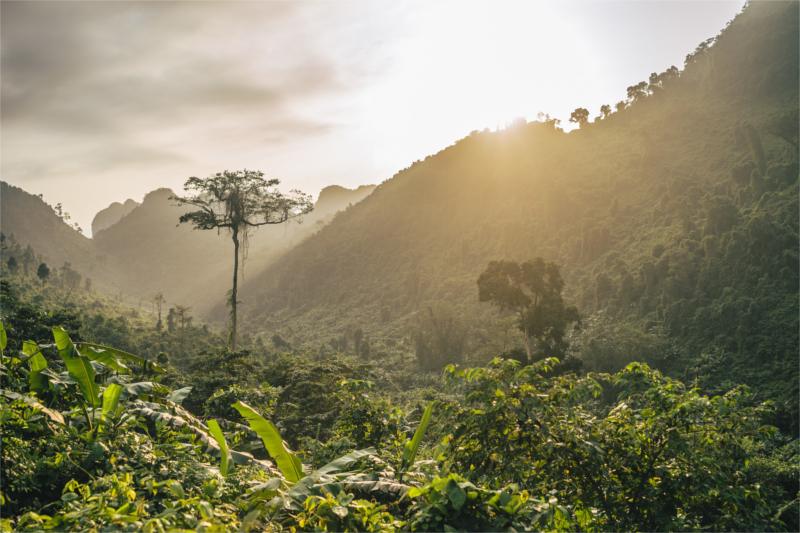In Central America between the Caribbean Sea and the Pacific Ocean lies Costa Rica, a land of unparalleled natural beauty, rich biodiversity, and diverse ecosystems and climates. This enchanting country boasts a spectrum of climate zones that contribute to its astonishing variety of landscapes, flora, and fauna. From tropical beaches to misty cloud forests, Costa Rica’s climate zones offer a fascinating tapestry of environments waiting to be explored.
- Tropical Lowlands:
Costa Rica’s coastal regions are a testament to the country’s tropical lowlands. These areas experience a hot and humid climate year-round, with average temperatures ranging from 75°F to 95°F (24°C to 35°C). The northern Pacific coast, known as the Guanacaste region, features a dry tropical climate characterized by savannas and dry forests. Its stunning beaches, warm waters, and abundance of recreational activities make it a prime destination for beach lovers and adventure seekers.
The Caribbean coast, in contrast, receives more rainfall due to its proximity to the moisture-laden Caribbean Sea. This leads to lush rainforests and vibrant ecosystems. Vacate in a tropical climate here sustains a plethora of wildlife, including the iconic toucans, sloths, and various reptiles. The Tortuguero National Park, a nesting site for endangered sea turtles, showcases the importance of the region’s wet climate for these remarkable creatures.
- Central Valley:
Venturing inland, you encounter the temperate climate of Costa Rica’s Central Valley. With elevations ranging from 2,800 to 4,000 feet (850 to 1,220 meters), this region offers milder temperatures compared to the coastal areas. Average temperatures hover between 65°F to 80°F (18°C to 27°C), making it an inviting place to live and visit.
The Central Valley is home to bustling cities like San José, Costa Rica’s capital. Its favorable climate and fertile volcanic soils have fostered agriculture, supporting crops like coffee, vegetables, and flowers. The coffee plantations in this region benefit from the cooler temperatures, resulting in some of the world’s finest coffee beans.
- Cloud Forests:
As you ascend further into the mountains, you encounter one of Costa Rica’s most enchanting climate zones: the cloud forests. Situated at elevations of 4,000 to 8,000 feet (1,220 to 2,440 meters), these mist-shrouded realms offer a unique and captivating environment. Average temperatures range from 50°F to 70°F (10°C to 21°C), creating a temperate climate unlike any other.
Monteverde, a world-renowned destination, is home to one of these ethereal cloud forests. The constant humidity and enveloping cloud cover provide ideal conditions for an array of plant and animal species, including the iconic resplendent quetzal. Orchids, ferns, and mosses flourish here, creating an otherworldly landscape that feels straight out of a fairy tale.
- Highland Zones:
Continuing your journey upward leads you to the highland zones, where temperatures become cooler and more refreshing. Regions like the Talamanca Mountains boast elevations exceeding 8,000 feet (2,440 meters), with temperatures ranging from 45°F to 65°F (7°C to 18°C).
These highlands are a testament to the adaptability of life. Páramos, alpine tundra ecosystems, and subalpine forests characterize these regions. The hardy flora and fauna that thrive here have evolved to withstand the challenges of high-altitude living.
- Rainforests and Wetlands:
Costa Rica’s climate zones also encompass expansive rainforests and wetlands, further enriching its ecological diversity. The Osa Peninsula, for instance, is a haven of biodiversity where lush rainforests flourish. The heavy rainfall creates ideal conditions for myriad species, including jaguars, monkeys, and countless bird species.
Wetlands, such as those found in Tortuguero National Park, highlight Costa Rica’s commitment to conservation. These interconnected waterways and lagoons are crucial breeding grounds for sea turtles, emphasizing the vital role these areas play in preserving endangered species.
Costa Rica’s climate zones are a testament to the intricate dance between geography and climate. The country’s relatively small size belies its remarkable diversity, offering a tantalizing array of landscapes for travelers and nature enthusiasts to explore. Whether you’re unwinding on sun-soaked beaches, trekking through enchanting cloud forests, or discovering the hidden wonders of highland ecosystems, Costa Rica’s climate zones offer an extraordinary opportunity to connect with nature in all its splendor.
The ecological richness and biodiversity of Costa Rica owe much to these climate zones. Each zone creates unique habitats that support an astonishing variety of species, from the tiniest insects to the most majestic mammals. This intricate balance showcases the importance of environmental preservation and sustainable practices.
In a world where climate change and human impact are increasingly concerning, Costa Rica’s example serves as a reminder of the fragility and resilience of our planet’s ecosystems. By understanding and appreciating the diverse climate zones that shape Costa Rica’s landscape, we can glean insights into the intricate web of life and how we, as stewards of the Earth, can contribute to its continued vitality.


 +1 888-818-2097
+1 888-818-2097
 +506 8932-4731
+506 8932-4731